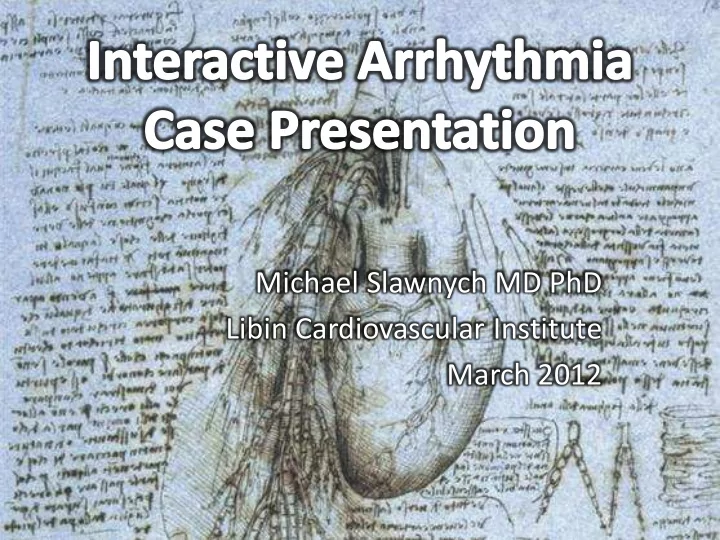

Michael Slawnych MD PhD Libin Cardiovascular Institute March 2012
Case • 62 Year Old Male – Retired airline pilot – Paroxysmal atrial flutter • Two previous CTI ablations – HTN – “Other prior ablations”
Case • 62 Year Old Male – Notes a return of episodic palpitations • Presents with sustained palpitations & pre- syncope – Medications: • Amiodarone 300 mg OD • Metoprolol 50 mg PO BID • Fosinopril 40 mg PO OD
ECG 1 What is the most likely diagnosis? 1. AVRT 3. Atrial fibrillation 5. Sinus tachycardia 2. AVNRT 4. Atrial flutter
Biblo et al. Am J Cardiol 2001
• Perception: – risk of stroke lower with AFlutter vs. AF. • Reality: – little difference in risk for AFlutter (1.4) & AF (1.6). • By 8 years, more than 50% of patients with AFlutter had developed AF, and these patients were more likely to experience a stroke.
3.5 Patients With Atrial Flutter “For patients with atrial flutter, we suggest that antithrombotic therapy decisions follow the same risk- based recommendations as for AF.”
Back to the Case • 62 Year Old Male – Patient was discharged from hospital on increased medical therapy: • Metoprolol 100 mg PO BID • Carvedilol 12.5 mg PO BID • Amiodarone 200 mg PO OD • Warfarin – But … • Returns to hospital with a recurrence of palpitations and pre-syncope
ECG 2a Regarding the presence on an accessory pathway? 3. Maybe – can’t tell 1. Yes – it’s there 4. Is that a new stent? 2. No – it’s not
ECG2b This is? 3. Non-sustained A Flutter 1. Non-sustained VT 4. Non-sustained A Fib 2. Non-sustained SVT
ECG 2c This is? 3. Non-sustained A Flutter 1. Non-sustained VT 4. Non-sustained A Fib 2. Non-sustained SVT
ECG 2d Regarding the presence on a re-entrant circuit ? 3. Maybe – can’t tell 1. Yes – it’s there 4. Wow – I am lost 2. No – it’s not
ECG 2c in Detail R P R R • Long RP Tachycardia: – ectopic atrial tachycardia – atypical AVNRT (fast-slow AVNRT) – orthodromic AVRT • due to an uncommon concealed accessory pathway with decremental properties
How to Refine the Diagnosis …
ECG 3
ECG 3 CL1 = 400 msec CL2 = 365 msec
ECG 3 CL1 = 400 msec CL2 = 365 msec Regarding the presence on an accessory pathway ? 1. Yes – it’s there 2. No – it’s not
Diagnosis? What’s the next best diagnostic step ? 1. Holter 2. Give adenosine with next episode 3. Coronary angiogram 4. Invasive EP study
EP Lab Findings … (1 of 2) • Patient entered lab in counterclockwise isthmus dependent flutter – Attempts to entrain this rhythm produced clockwise isthmus dependent flutter – Cavo tricuspid isthmus ablation produced bidirectional isthmus block. Regarding the arrhythmia? 1. It is typical atrial flutter 2. It is atypical atrial flutter
EP Lab Findings … (2 of 2) • Inducible non-sustained AVRT using a left posterior accessory AV connection (retrograde) and the AV node (anterograde) – Successful ablation via trans-septal approach Regarding the arrhythmia? 1. It is antidromic AVRT 2. It is orthodromic AVRT
Discussion • Prolongation of SVT cycle length with functional BBB is most consistent with an AVRT with the location of the accessory pathway in the same ventricle that gave rise to the BBB
Discussion • Circuit uses ipsilateral BB. A - atrium AVN – AV node BB – bundle branch H - bundle of His V - ventricle CL1 = 395 msec
• With a BBB ipsilateral to Discussion the AP, the additional conduction time prolongs the cycle length. A - atrium AVN – AV node BB – bundle branch H - bundle of His V - ventricle CL1 = 395 msec CL2 = 420 msec
Key Points • Atrial flutter still warrants anticoagulation • DDX for SVT with long RP • Heart rate < 150 bpm can occur with atrial flutter after CTI ablation/alteration • Slower CL with BBB versus non-BBB = AVRT – lack of delta does not exclude AVRT
Recommend
More recommend